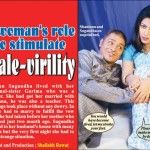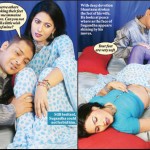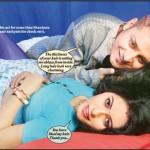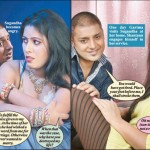In the Indian hinterland, crimes of passion happen every single day, and perhaps nowhere are they so lovingly archived in all their recreated technical glory as Crime & Detective. Like many other Indians, Kai Friese found it hard to make a train journey without the pulpy lubricant offered by the magazine; unlike any others, he took his interest one step further by meeting the men behind India’s most original and passionate publishing empire.
Like most people in India, I picked up my first copy of Crime & Detective from a magazine kiosk on a railway platform. This soon became a habit, and now I can never board a train at one of Delhi’s railway stations without first squelching through the seabed of grime, spit and mulch that coats its platforms like a trampled, oozing metaphor to pick up a copy of my favourite sex-crime magazine. A railway journey in the company of C&D is a balm for the ennui and alienation that sometimes gnaws at effete urbanites like me. The zoetrope of other people’s lives flickering through the window frames, the snatches of conversation in so many tongues, the brutal but salutary collision of air as we cross paths with yet more lives rushing past in the opposite direction – and through it all ticks the reassuring metronome of C&D’s headlines from the far corners of our great nation. Faridabad: “Aunty’s sinful relation with nephew led to uncle’s death.” Jabalpur: “Immoral relationship turned disastrous.” Rampur: “May the Almighty save parents from such daughters.” Muzaffarnagar: “Lost in mad love the woman committed incredible crime.” Raipur: “Paramour proved more important than husband.” Delhi: “Sex-addicted wife battered drunkard hubby to death.” Delhi: “Double life of a woman: two husband and two religion.” Why the hell I should find comfort in such reportage (I’m a married drunkard from Delhi), only the Shadow knows.
Well, him and two other gents: Satish Verma, editor of C&D, and Shailabh Rawat, editorial consultant to the same publication, and my hero. Fulfilling a long-cherished ambition to meet them, I take a cab to the unfamiliar reaches of the North Delhi neighbourhood of Dr. Mukherjee Nagar and the office of Nai Sadi Prakashan, publishers of C&D and its vernacular big sisters Madhur Kathayen (“Honeyed Tales”) and Mahanagar Kahaniyan (“Stories of the Metropolis”). It’s a moment of Sam Spade-ish theatricality for me as I’m ushered into the editorial cabin. Verma is a tidy figure in a suit and a French-cut beard; Rawat affects a more journalistic insouciance, except for his unnaturally black hair. We soon fall into tribal courtesies – I’m a magazine editor myself – and hierarchy is established along with circulation figures. Theirs are well beyond my wildest aspirations. Their success, says Verma, is based on the “True Story” formula, a concept he maintains was missing from the English-language press, at least in India. “The genre was invented in Hindi publications and now we translate these true-life stories for Crime & Detective,” Verma explains. “There are no English-language reporters who can be bothered to spend so much time with the police.”
I’m reminded of vintage magazines I know only through publishing legend. True Crime and Confidential were pulpy products with late-Victorian antecedents and a North American heyday in the 1930s. I don’t know what killed the genre in the West or whodunit, but if I were given to sociologising I would speculate about the necessary role of true-crime magazines as a pulpy lubricant for societies characterised by grinding disparity and thwarted ambition.
That said, C&D’s lubriciousness has a uniquely local consistency. These “true crimes” are also truly Indian fantasies. “Storytelling is as important as reporting,” Verma says. The storytellers’ craft is reflected in the large swathes of fictionalised dialogue and scenarios that enliven what might otherwise be slightly depressing tales of desperate lives and sticky endings. Thus, a feature from January entitled “Liaison with NRI aunty” describes the seduction of a strapping young Punjabi hayseed, Baljinder (alias Bubby), by his “lecher mausi” Jatinder Kaur, a maternal aunt visiting from Finland (an NRI is a non-resident Indian or expatriate). The scenes are leavened by exchanges such as, “She stretched her hand within his underwear in one go only. When due to utter nervosity Bubby tried to get down from the bed and run away Jatinder firmly held his ‘reign’. ‘Mausi, you are committing a sin! Please release me as I am a child in front of you.’”
Or this tableau, which could be straight out of a Punjabi version of Body Heat, “Jatinder Kaur got flared up with libidinous urge to such an extent that she couldn’t control her feelings. She got up from her bed and came to Bubby’s bed, sweat drops appeared on her forehead due to volatile sex-urge.” Inevitably, Bubby is seduced and then, inflamed by lust and the prospect of a new life in Finland, plots with Jatinder to kidnap and murder her husband. Oh dear. It all ends very badly, with “a chopper used for killing the goats” for uncle and jail for aunty and Bubby.
Sadly, it is a true story, and like all the features in C&D, it closes with black-and-white mugshots of the arresting officers. It’s a visual cold shower after the lurid colour of the staged “title shots” on the opening pages, with models re-enacting Jatinder and Bubby’s criminal passion. That’s a fairly typical C&D true-crime treatment, a roller-coaster ride of unsatisfied, insatiable women, virile lunkheads, lust, jealousy, violence and greed – emotions and temptations in which the reader is soon complicit, only to breathe a sigh of relief, as the ticket inspector comes round, that your only true crime is to have read a Crime & Detective in a public compartment. Phew!
But the real reason I’m hooked on C&D is not the crime stories. It’s the “photo fiction.” These are seven-to eight-page short stories, in photo-comic form, usually scripted by Shailabh Rawat and enacted by “strugglers” – aspiring actors and models in Mumbai. There is a Bollywood B-movie fleshiness about these productions, which Rawat tells me cost approximately 30,000 rupees (about £400). The photo fictions share the dialectic of morality and salaciousness with the magazine’s crime features. But they are less brutal in denouement, sometimes almost sweet, and often really weird. The stories range from folk-tale staples like the lecherous priest to surprisingly contemporary themes. One of my favourite titles is “Being Wife of a Gigolo” (July 2005). The inspiration, says Rawat, comes from the swamp of “true stories” in which he has worked for the last 20-odd years. The comic that follows was originally scripted for Madhur Kathayen’s annual Transsexual Special. “It’s a very popular issue,” says Verma. “We take it very seriously. Every year we get hundreds of desperate letters from readers who say they have nowhere else to turn – they can’t discuss their sexuality with family or friends.”
Call me a romantic (or a pervert), but I think there is something wonderful about this bizarre, genre-bending magazine that mixes voyeurism, hardboiled crime reporting and the unintended humour of a bilingual idiom with such utterly nonchalant brassiness. And I can’t imagine any of my LGBTI friends coming up with something as transgressive (or popular) as Madhur Kathayen’s transsexual annual if their MacArthur grants depended on it.
Before I leave Dr. Mukherjee Nagar, the C&D editors and I chat about the recent disappearance of burlesque dancing in the city. As native Dilliwallas of a certain age, we exchange knowing smiles and nods of acknowledgement. “Blue Star Cabaret – well, you had to wait for the last act for the real thing.” “The Pussycat Discotheque! That was more of a pick-up joint for call girls from GB Road masquerading as students from South Ex.” I hold my own – briefly. But soon I realise I’m just treading water, while their knowledge laps and dances like a dark ocean of noir.
Thanks to the Power Money Sex Reader.
















